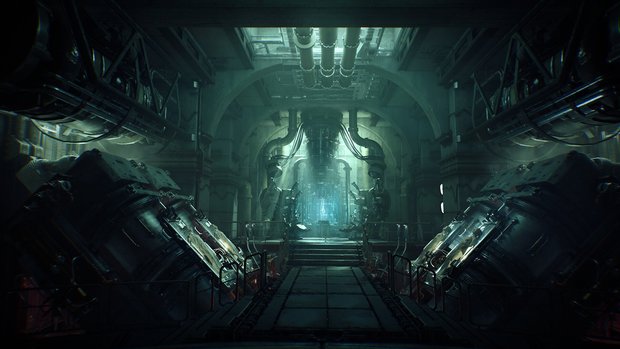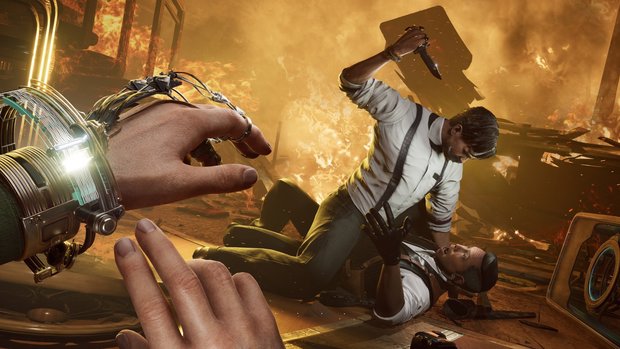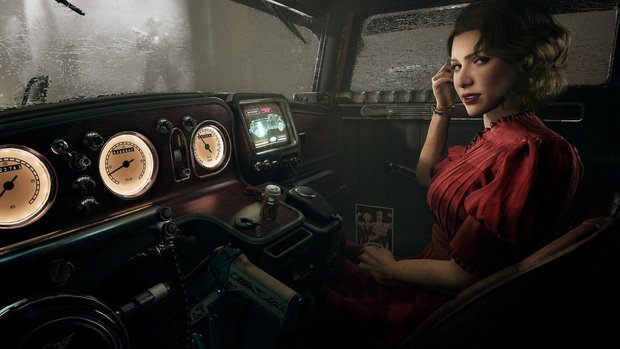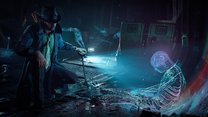Nobody Wants to Die review

- 1 Comment
Strong production values bring dystopian tech-noir mystery to life, though it's so streamlined you'll only get to experience it in passing
When Freddie Mercury asked “Who wants to live forever?” he couldn’t have foreseen the response in Critical Hit Games’ tech-noir mystery Nobody Wants to Die. The answer here is as somber as it is depressing, because in 24th-century New York City, immortality is a deplorable and morally bankrupt business practice that is strictly controlled and regulated, where individuals’ rights and well-being are routinely discarded and abused. The city is a dark and nihilistic place full of corruption and extreme consumerism, where life is bought and sold, while those without means suffer instead. It all makes for a compelling setting for a gritty crime thriller that sees you investigate a spree of brutal killings, leaning into its sci-fi trappings through some very cool futuristic tech used during crime scene examinations. While the background lore isn’t quite fleshed out enough to give the serial murder case all the oomph it deserves, the game’s cast of characters are enjoyable highlights that benefit from memorable story beats and world design to make their journey well worth experiencing.
Detective James Karra checks all the boxes of a classic pulp gumshoe, even if he’d rather zip through the Big Apple in his flying car than hoof it around its streets. As a veteran of the city’s police force, where he’s served in the Mortality Department for the better part of a century, James is aware of the corruption running rampant through its upper echelons, while privately suffering from a multitude of personal demons that have him diving to the bottom of more than his fair share of bottles of rotgut. After recently being involved in a large-scale public catastrophe (of which we know little at first but learn more as it begins to figure increasingly into the narrative), James has been placed on administrative leave and is itching to give his idle mind something to keep it busy again.
As if on cue, he receives an off-the-record request from his C.O. to look into the suspicious death of Edward Green, a high-profile businessman and politician. Green is one of the people responsible for ushering in the practice of transferring one’s consciousness to a newer, younger physical model, complete with that new-body smell. This medical breakthrough centers on harvesting ichorite, a substance containing a person’s thoughts, feelings, and knowledge – their self – and transplanting it into a new body. As one of the pioneers responsible for what has quickly become a widespread medical practice, Green has of course planned for contingencies and minor setbacks like death, and James must retrieve the man’s ichorite to initiate a new body transplant before the general populace gets wind of it and a scandal ensues.

Here’s where the confusion began to set in, as I was never really clear on the need for the cloak-and-dagger antics. Still, the vision of the future presented here is as fascinating as it is bleak and terrifying, with a plethora of implications both good and bad. Unfortunately, while Karra’s own struggles provide a solid character backdrop, the case he’s pulled into only superficially delves into the political arena surrounding these controversial consciousness transfers – more specifically, the divergent availability of said technology for the haves versus the have-nots, the level of crippling and lifelong debt incurred by those who partake in it, and the somewhat troublesome issue of the resupply of bodies to meet growing demand.
There is probably a full novel’s worth of backstory, exposition, backroom machinations, and political maneuvering inherent in the game’s lore, with Karra’s investigation seeing him cross paths with some of this city’s top movers and shakers. It’s a shame, then, that the three crime scene investigations aren’t enough to fully steep us in this twisted world and let us become as intimately familiar with its sordid cast of characters and ethical implications as it could have. As a result, it never really succeeded in pulling me any deeper into its broader world-building aspects beyond a perfunctory sense of “rich people bad.”

Without departmental regulations tying him down, Karra is able to operate with a bit more moral ambiguity than the official boys in blue also closing in on Green’s posh penthouse suite. But Karra’s bosses know better than to completely let him go rogue, and so he is saddled with a police liaison contact, rookie officer Sara Kai, who lends Karra support via constant voice communication. With Sara in his ear and the controls of his flying car gripped tightly in his hands, Karra hightails it to Green’s penthouse.
It's once you’ve arrived at the crime scene – and the couple more that follow – that the game’s central mechanic kicks in. Like any good detective worth his salt, Karra must carefully investigate each location to piece together clues and uncover what exactly happened, but thanks to the science fiction trappings, he has a unique ace up his sleeve to assist him. Karra wears a Reconstructor, a wrist-mounted gadget that not only lets him see what occurred but actively allows him to interact with the simulation as he rewinds and fast-forwards time. This scrubbing mechanic allows you to delve into individual aspects of each scene or follow various threads of the case all around the area as a veritable web of criss-crossing pieces of evidence reveals itself.
For example, at one point Karra, on the trail of a suspect, arrives at a gin-joint-style bar moments after a great explosion devastated the premises. Scanning the bodies quickly reveals that a chaotic firefight preceded the destruction, with bullets arcing through the space along rippling trails that Karra can follow back and forth as he slowly works out who fired at whom, and just as importantly, why. It’s an extremely stimulating mechanic that allows for big action set pieces without ever putting you in danger or requiring masterful reflexes to come out on top, as all the action has already happened by the time you get there. More importantly, having access to tech like this dovetails nicely with the game’s futuristic setting and makes for an exciting virtual twist on classic sleuthing gameplay.
All this investigative potential is somewhat undercut, however, by the game keeping you on a rather tight leash – especially during these investigations – and ushering you down a linear narrative corridor as you uncover evidence and story details in a prescribed order so the mystery will unravel as intended. There’s always an objective to work towards – a specific person to ID, a particular scan to perform, a vital connection to make – but it feels more like ticking off boxes on a checklist rather than being cut loose to follow your bloodhound senses. To be fair, objectives aren’t a bad thing, but here they act to rein you in rather than propel you forward, keeping your detective work on a straight and narrow path. And while James and Sara will often suss things out together, some of the implications they discover won’t resonate very strongly without players having some grasp of all the political machinations involved. In the end, I very much wanted to experience my own neurons and synapses firing as I actively pursued the mystery before me rather than simply going through prescribed, albeit cool, motions.

Even a super sleuth needs to regroup from time to time to thoroughly connect all the dots, leading to a deduction mini-game at key moments in the story. The general idea works similarly to deduction board sequences in other mystery games, though once again with a futuristic twist. Using the holographic projector in Karra’s apartment, all collected evidence, persons of interest, and other pertinent discoveries are represented as tangible objects and must be matched with one another in certain combinations to allow James and Sara to make important deductions. However, this sci-fi facelift doesn’t do much to mask the relatively standard premise of the task. The bigger problem is that the logic leaps required to know which pieces to combine failed to click for me at times, or else I was missing bits of important context the world-building failed to provide, so I either fumbled my way through these sections or simply tolerated them as a necessary piece of progression to move on to the next investigation.
While getting the most out of the mystery would require a bit more background exposition, the physical world of Nobody Wants to Die is a fascinating place to spend six or seven hours in. This becomes evident immediately, as seen through the eyes of James as he’s sitting in his car, apparently parked at a black-and-white drive-in movie show with his wife Rachel in the passenger seat. As the curtain is pulled back, however, it’s revealed that she is nothing but a figment of his imagination – and, perhaps, a piece of his tortured past – and we see that his vehicle isn’t parked in front of a silver screen but rather hovering high up in the air above Times Square in front of a jumbo-sized display, dangerously far above the concrete canyons marking the distant city streets below.
Though there’s little license to scour the city and no freedom at all to go off the beaten path and explore (James’s vehicle autopilots him from one self-contained location to the next), a few choice locales did immerse me in a satisfying and organic way. The lion’s share of the heavy lifting is performed by the protagonist’s apartment, which naturally acts as a hub throughout your investigation. Navigated using the standard WASD/mouse combination or gamepad, it is stuffed to the brim with small environmental storytelling details that go a long way to bringing James’s past to life. For example, there’s a sealed door that appears to lead to some sort of nursery or playroom, bearing a young boy’s name that’s never commented on yet suggests much about James’s troubled background. Likewise, traversing the metal catwalks outside the apartment leads you to a precarious perch that provides James with a spot to grab a smoke, stare into the neon-choked expanse surrounding his tenement building, and ponder the case or just life in general. It may not be a highly interactive world, but there are some genuinely intriguing character moments spent in it, at least from time to time.
Apart from the three official crime scenes, there are a few additional environments that let you venture into other parts of this neo-New York City. You’ll of course visit future Central Park, which here plays host to a chaotic protest sweeping through its parks and pathways – one of the game’s welcome if too infrequent attempts at world-building sprinkled throughout. A far more impactful highlight, however – and more critical to infusing the game with a solid sense of place – is when James leaves the city’s upper elevations behind and descends into the slums where the poorest of the poor live in deplorable conditions. Being greeted by the severed head of the Statue of Liberty lying amidst shacks and hovels as Karra circles in the sky overhead is nothing if not a jaw-dropping example of eye candy achieved by the visual design team. In fact, the game looks gorgeous pretty much throughout, with high production values at play in the handful of polished 3D environments. The city’s perpetual gloom contrasts beautifully with large, colorful holographic billboards of femme fatales selling dreams, neon signage soliciting business, and skyscrapers and high-rises as far as the eye can see, blinking with lights like a colony of urban Christmas trees.
The game’s sound is as good as its graphics. As befits a hard-nosed noir crime thriller, much of the score sounds like it's been ripped right out of the nearest speakeasy and makes ample use of a well-staffed orchestral brass section. Both James and Sara are expertly voiced, with nuanced touches coming from optional dialogue choices that allow you to inject a bit of role-playing into the proceedings. Should James be considerate and reserved, or is he a brash and tempestuous jerk who routinely lays on his car horn and reaches for his hip flask on a regular basis? As decisions concerning James’s conduct are made, dialogue choices unlock and become available on the fly, while on-screen prompts inform you that your choices will influence the story’s outcome in some way. There are reportedly two main endings available, as well as minor variations that play out during the credits, and it is up to you whether James himself will receive a measure of redemption at the end of his investigation.
Final Verdict
Nobody Wants to Die is a game that seems tailor-made for an outstanding sizzle reel of trailer highlights. It looks and sounds like a million bucks and introduces a clever time-manipulation mechanic to allow for novel crime scene investigations. But beyond the glitz and glamour, I had a hard time connecting sufficiently with the pervading dystopian lore to give the case the high stakes it deserved. Moreover, the linear investigations didn’t let me stretch the puzzle-solving parts of my brain enough. After a first crime scene that felt more like a linear tutorial, I assumed that I would be turned loose to follow my own intuition in later investigations, but the need to keep the narrative trickling along continually constrains the player’s own sleuthing. It’s a world that shows lots of promise, and is punctuated by strong character moments throughout, so I’d gladly revisit it again. If there ever is a sequel, here’s hoping a sophomore effort manages to bring the gameplay in line with the more satisfying aspects already in place.
Hot take
Immortality is within reach for this stylishly produced noir detective thriller about the misery of eternal life, but limited world-building and player agency prevent Nobody Wants to Die from becoming a once-in-a-lifetime experience.
Pros
- Breathtaking depiction of a cold and callous futuristic NYC
- Intriguing time-manipulation mechanic for investigating murder scenes
- Excellent character moments achieved via engaging world design
- Expertly crafted soundtrack and voice-over work really sell the hard-nosed crime noir vibe
Cons
- Investigating crime scenes feels like following a trail of breadcrumbs
- Needs more exploration of the important broader political backdrop
- Deduction board mini-game is a step down from the main investigation sequences
Pascal played Nobody Wants to Die on PC using a review code provided by the game's publisher.











1 Comment
Want to join the discussion? Leave a comment as guest, sign in or register in our forums.
Decapitated Statue of Liberty? So it's a post-Cloverfield game? ;)
Reply
Leave a comment